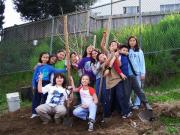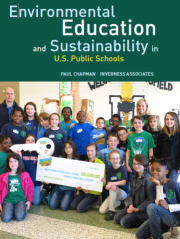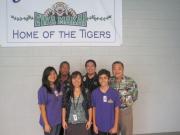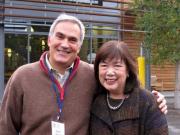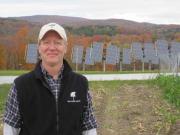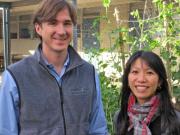Growing Connections: Formal and Informal Environmental Education in the Bay Area
Anticipating the release of my second book, Greening America's Schools 2.0, in February at the National Association of Independent Schools Annual Conference in Philadelphia, I have begun a long-term research project to evaluate the state of environmental and sustainability education in Bay Area private schools. This study especially seeks to understand the connections between the formal, K-12 green schools efforts and the invaluable education that is offered by a network of informal environmental education institutions. It is my hope that the research will enable us to grow stronger connections between the two communities here in California, and in so doing suggest best practices for regional associations around the country. The report is due out in late spring.
Growing Connections: The Link Between California Private Schools and Informal Environmental Education
When I first met Stanford University professor Nicole Ardoin at Starbucks in Palo Alto in 2010, I learned the distinction between “formal” and “informal” environmental education (EE). She told me about her work as an interpretive ranger at the Grand Canyon, a museum educator in Washington DC, and an education specialist with World Wildlife Fund that inspired her get a Ph.D. in Forestry and Environmental Studies from Yale. And she shared her perspective about the critical role experience in nature plays in developing environmental literacy. As a just-retired school principal, I offered my belief that schools can make a big difference in students’ development as environmental stewards. Ever since that first conversation, I have been exploring the connections between these two essential elements in environmental education.
In recent years the environmental education movement has grown rapidly, in part as a response to the global sustainability challenges we face, and also because of the recognition that environmental education offers an approach in which students learn effectively. Informal environmental education providers—museums, aquariums, science centers, outdoor education programs, and conservation organizations—play a significant role in helping people gain environmental awareness, knowledge, skills and attitudes and learn to behave in environmentally sensitive ways. At the same time, formal environmental education efforts have been expanding rapidly in schools in recent years, and research demonstrates the important role they play in developing environmentally literate citizens. While the relationship between the informal and formal environmental education communities is critical to developing young environmental stewards, relatively little has been written about that connection.
With the support of the new Bay Area Environmental Education Collaborative and the S. D. Bechtel, Jr. Foundation, I am conducting a research project that will begin to address that gap in our knowledge by studying environmental education in the private schools of 12 Bay Area counties. In so doing, I will suggest ways to promote stronger collaboration between the two communities. The study of over 500 private schools, through extensive survey research, interviews and site visits, explores several essential questions: What is the state of environmental education and sustainability efforts in Bay Area private schools? Why do schools adopt environmental education programs and what challenges do they face in that process? In what ways and to what degree do schools engage with the informal EE community and network of institutions and resources? What would schools like to see from the informal EE community to strengthen their programs?
The goal of the new Environmental Education Collaborative (Collaborative), which is sponsoring the research, is to ensure that every generation has environmental know-how and is inspired to make the world a better place. The Collaborative is a group of eight institutions that have extensive environmental education programs for a wide range of audiences including families, educators, and students, as well as the wider public audiences reached by the Collaborative partner organizations: the California Academy of Sciences, the Exploratorium, Golden Gate National Parks Conservancy, Lawrence Hall of Science, Monterey Bay Aquarium, NatureBridge, Pie Ranch, and Tuolumne River Trust. Formed in 2011 and comprised of Bay Area EE providers and academic researchers, the group is “creating a strategic plan and road map to strengthen and build the field of environmental education, while helping to create a unified voice for the field.” The Collaborative intends to strengthen the connection between research and practitioners in the field, improve the relevance of EE for “people from socioeconomically and culturally diverse communities,” develop a “wider range of sectors and stakeholders (e.g., for-profit, public, philanthropic) in the design and delivery of the environmental education system,” and increase collaboration to “facilitate unity in message, vision, and standards as well as growth in the scope and scale of environmental education programs.”
The San Francisco Bay Area is a hotspot of environmental sustainability and the Collaborative leadership is charting new ground in their efforts. Jason Morris serves as the Collaborative's Chairman as well as Exeutive Vice President of NatureBridge, the country’s largest residential educational partner of the National Park Service, which operates environmental education campuses in six National Parks including Yosemite and Golden Gate and reaches more than 40,000 youth per year. Raised on a farm in Colorado, Jason developed a love of nature hiking in Rocky Mountain National Park. A forceful advocate for the importance of environmental literacy in developing a more sustainable future, he has helped NatureBridge become one of the premier environmental education providers in the West. As one of the Strategic Advisors for the Collaborative, Nicole Ardoin helped guide the birth of this new group. Its work is influenced in part by her own research to understand what motivates environmental behavior, especially a “sense of place” and “geographic scale” and by her experience in environmental education program evaluation in settings such as environmental education centers, parks, natural history museums, zoos, and aquariums. The work of the Collaborative is connected with her Environmental Learning in the San Francisco Bay Area research study, in which she and her team are investigating the links between environmental learning and environmental behavior within the course of people’s everyday lives. Another member of the Collaborative, Deb Wojcik, is postdoctoral scholar with a joint appointment in the School of Education and Woods Institute for the Environment at Stanford, where she serves as project manager and researcher for the Environmental Learning. With a Ph.D. in Forest Resources and Conservation from University of Florida and Master of Environmental Management, M.A.T., and B.S. degrees from Duke University, she strengthens the relationship between research and practice. The Collaborative’s full complement includes the environmental educational program leaders from the eight participating institutions. Taken together, they constitute an experienced and skilled team working to strengthen environmental education in the Bay Area.
The final report on the study of Bay Area private schools will be released later in 2013. It is my hope that by illuminating the relationship between California private schools and informal environmental education, we will be able to grow greater connections between two communities responsible for raising the next generation of environmental stewards.
